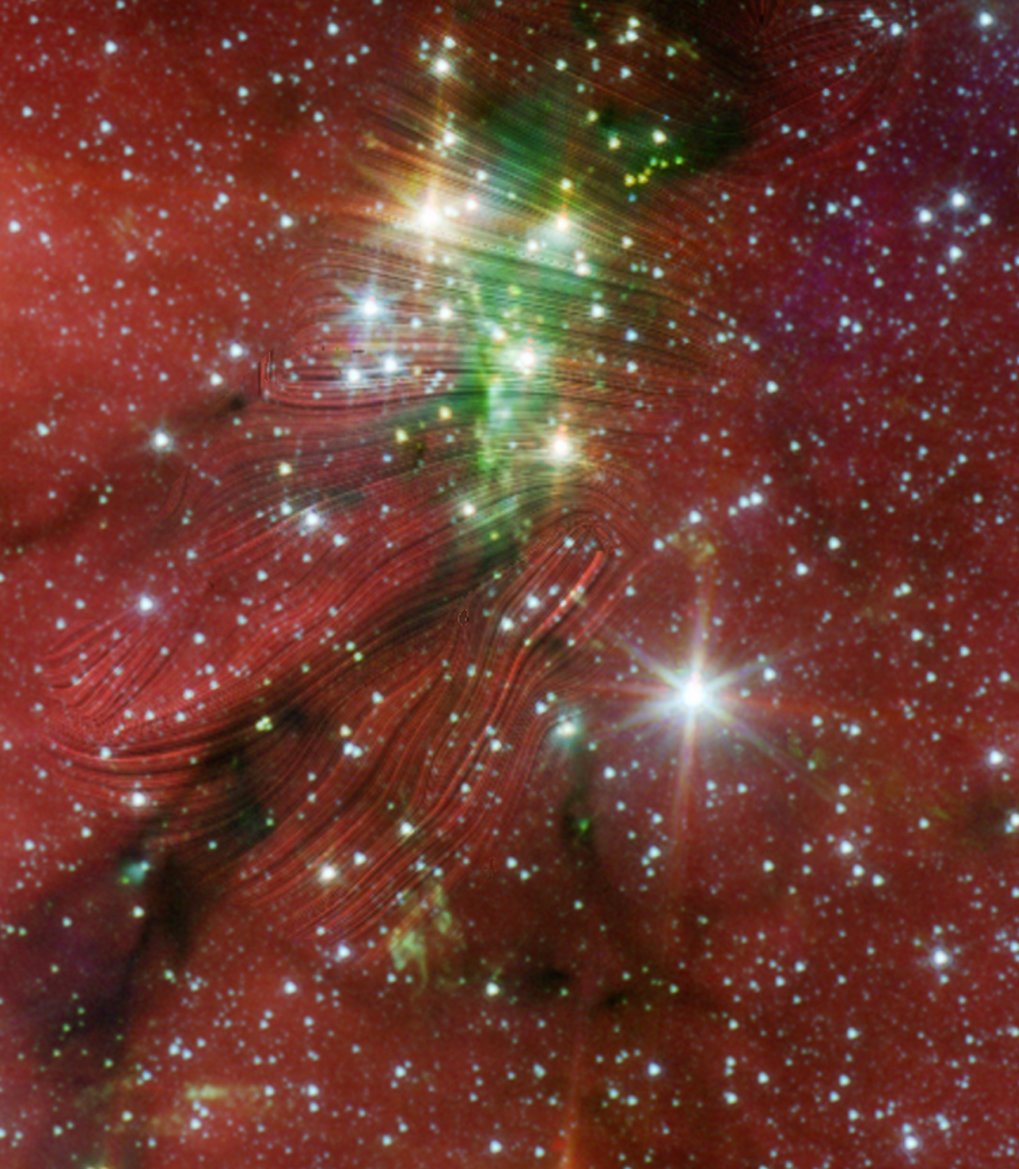
From Max Planck Institute for Radio Astronomy
August 18, 2020
Dr. Thushara Pillai
tpillai@bu.edu
Boston University, Boston, USA
Prof. Dr. Karl M. Menten
Direktor und Leiter der Forschungsabteilung “Millimeter- und Submillimeter-Astronomie”
Phone:+49 228 525-297
Prof. Dr. Karl M. Menten
Direktor und Leiter der Forschungsabteilung “Millimeter- und Submillimeter-Astronomie”
Phone:+49 228 525-297
kmenten@mpifr-bonn.mpg.de
Dr. Norbert Junkes
Press and Public Outreach
Phone:+49 228 525-399
njunkes@mpifr-bonn.mpg.de


Observations of magnetic fields in interstellar clouds made of gas and dust indicate that these clouds are strongly magnetized, and that magnetic fields influence the formation of stars within them. A key observation is that the orientation of their internal structure is closely related to that of the magnetic field.
To understand the role of magnetic fields, an international research team led by Thushara Pillai, Boston University & Max Planck Institute for Radio Astronomy (MPIfR) in Bonn, Germany, observed the filamentary network of the dense gas surrounding a young star cluster in the solar neighboorhood, with the HAWC+ polarimeter on the airborne observatory SOFIA at infrared wavelengths. Their research shows that not all dense filaments are created equal. In some of the filaments the magnetic field succumbs to the flow of matter and is pulled into alignment with the filament. Gravitational force takes over in the denser parts of some filaments and the resulting weakly magnetized gas flow can feed the growth of young stellar clusters like a conveyor belt.
The results are published in this week’s issue of Nature Astronomy.

Composite image of the Serpens South Cluster. Magnetic fields observed by SOFIA are shown as streamlines over an image from the Spitzer Space Telescope. SOFIA indicate that gravity can overcome some of the strong magnetic fields to deliver material needed for new stars. The magnetic fields have been dragged into alignment with the most powerful flows, as seen in the lower left where the streamlines are following the direction of the narrow, dark filament. This is accelerating the flow of material from interstellar space into the cloud, and fueling the collapse needed to spark star formation.
© NASA/SOFIA/T. Pillai/J. Kauffmann; NASA/JPL-Caltech/L. Allen
It is understood from theoretical simulations and observations that the filamentary nature of molecular clouds actually plays a major role in channeling mass from the larger interstellar medium into young stellar clusters whose growth is fed from the gas. The formation and evolution process of stars is expected to be driven by a complex interplay of several fundamental forces — namely turbulence, gravity, and the magnetic field. In order to get an accurate description for how dense clusters of stars form, astronomers need to pin down the relative role of these three forces. Turbulent gas motions as well as the mass content of filaments (and therefore gravitation force) can be gauged with relative ease. However, the signature of the interstellar magnetic field is weak, also because it is about 10,000–times weaker than even our own Earth’s magnetic field. This has made measurements of magnetic field strengths in filaments a formidable task.
“The magnetic field directions in this new polarization map of Serpens South align well with the direction of gas flow along the narrow southern filament. Together these observations support the idea that filamentary accretion flows can help form a young star cluster”, adds Phil Myers from the Harvard-Smithsonian Center for Astrophysics, a co-author of the paper.
A small fraction of a molecular cloud’s mass is made up by small dust grains that are mixed into the interstellar gas. These interstellar dust grains tend to align perpendicular to the direction of the magnetic field. As a result, the light emitted by the dust grains is polarized — and this polarization can be used to chart the magnetic field directions in molecular clouds.
Recently, the Planck space mission produced a highly sensitive all–sky map of the polarized dust emission at wavelengths smaller than 1 mm. This provided the first large–scale view of the magnetization in filamentary molecular clouds and their environments. Studies done with Planck data found that filaments are not only highly magnetized, but they are coupled to the magnetic field in a predictable way. The orientation of the magnetic fields is parallel to the filaments in low–density environments. The magnetic fields change their orientation to being perpendicular to filaments at high gas densities, implying that magnetic fields play an important role relative in shaping filaments, compared to the influence of turbulence and gravity.
This observation pointed towards a problem. In order to form stars in gaseous filaments, the filaments have to lose the magnetic fields. When and where does this happen? With the order of magnitude higher angular resolution of the HAWC+ instrument in comparison to Planck it was now possible to resolve the regions in filaments where the magnetic filament becomes less important.
“Planck has revealed new aspects of magnetic fields in the interstellar medium, but the finer angular resolutions of SOFIA’s HAWC+ receiver and ground-based NIR polarimetry give us powerful new tools for revealing the vital details of the processes involved”, says Dan Clemens, Professor and Chair of the Boston University Astronomy Department, another co-author.
“The fact that we were able to capture a critical transition in star formation was somewhat unexpected. This just shows how little is known about cosmic magnetic fields and how much exciting science awaits us from SOFIA with the HAWC+ receiver”, concludes Thushara Pillai.
The research team comprises Thushara Pillai, Dan P. Clemens, Stefan Reissl, Philip C. Myers, Jens Kauffmann, Enrique Lopez-Rodriguez, Felipe de Oliveira Alves, Gabriel A. P. Franco, Jonathan Henshaw, Karl M. Menten, Fumitaka Nakamura, Daniel Seifried, Koji Sugitani, and Helmut Wiesemeyer. Thushara Pillai, the first author, and also Karl Menten and Helmut Wiesemeyer have an affiliation with the MPIfR.
See the full article here .
five-ways-keep-your-child-safe-school-shootings
Please help promote STEM in your local schools.


MPIFR/Effelsberg Radio Telescope, Germany
The Max Planck Institute for Radio Astronomy (German: Max-Planck-Institut für Radioastronomie) is located in Bonn, Germany. It is one of 80 institutes in the
